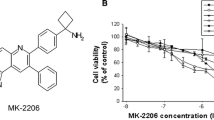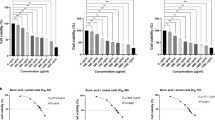Abstract
In the current study, we aimed to identify the cytotoxic and apoptotic effects of bortezomib (BOR) on human K562 chronic myelogenous leukemia cells and to evaluate the potential roles of Janus kinase/signal transducers and activators of transcription (JAK/STAT) pathway members STAT3, STAT5, and JAK2 on BOR-induced cell death of leukemic cells. Cell viability was assessed via trypan blue dye exclusion test, and cytotoxicity of the BOR-treated cells was conducted by 2,3-bis(2-methoxy-4-nitro-5-sulphophenyl)-2H-tetrazolium-5-carboxanilide inner salt (XTT) assay. The relative messenger RNA (mRNA) expression levels of STAT3, STAT5A, STAT5B, and JAK2 were analyzed by quantitative reverse transcriptase-polymerase chain reaction (qRT-PCR). On the other hand, their protein expression levels were detected by western blot method. The obtained results indicated that BOR treatment reduced cell viability and induced leukemic cell apoptosis in a dose- and time-dependent manner as compared to untreated control cells. While mRNA expression levels of STAT5A, STAT5B, and STAT3 were significantly reduced following BOR treatment when compared to untreated controls, it had no effect upon JAK2 mRNA expression. As for protein levels, STAT expressions were downregulated after BOR treatment especially at 72nd and 96th hours. Our results pointed out that BOR treatment had a significant potential of being an anticancer agent for chronic myelogenous leukemia therapy, and this effect could be due to the expressional downregulations of JAK/STAT pathway members.







Similar content being viewed by others
References
Nasr R, Bazarbachi A. Chronic myeloid leukemia. "Archetype" of the impact of targeted therapies. Pathol Biol. 2012;60(4):230–45.
Ramirez P, Dipersio JP. Therapy options in imatinib failures. The Oncologist Leukemias. 2008;13:424–34.
Bixby DL. Managing inadequate responses to frontline treatment of chronic myeloid leukemia: a case-based review. Cancer Treat Rev. 2013;39(3):241–51.
Kantarjian HM, Shah NP, Cortes JE, Baccarani M, Agarwal MB, Undurraga MS, et al. Dasatinib or imatinib in newly diagnosed chronic-phase chronic myeloid leukemia: 2-year follow-up from a randomized phase 3 trial (DASISION). Blood. 2012;119(5):1123–9.
Steinberg M, Steinberg M. BCOP. New drug dasatinib: a tyrosine kinase inihibitor for the treatment of chronic myelegenous leukemia and philadelphia chrosome-positive acute lymphoblastic leukemia. Clinical Thepeutics. 2007;29(11):2289–308.
Smoak KA, Cidlowski JA. Mechanisms of glucocorticoid receptor signaling during inflammation. Mech Ageing Dev. 2004;125:697–706.
Bromberg JF. Activation of STAT proteins and growth control. Biogeosciences. 2001;23:161–9.
Bromberg J. Stat proteins and oncogenesis. J Clin Invest. 2002;109:1139–42.
Catlett-Falcone R, Landowski TH, Oshiro MM, et al. Constitutive activation of Stat3 signaling confers resistance to apoptosis in human U266 myeloma cells. Immunity. 1999;10:105–15.
Levy DE, Gilliland DG. Divergent roles of Stat1 and Stat5 in malignancy as revealed by gene disruptions in mice. Oncogene. 2000;19:2505–10.
Costa-Pereira AP, Bonito NA, Seckl MJ. Dysregulation of janus kinases and signal transducers and activators of transcription in cancer. Am J Cancer Res. 2011;1(6):806–16.
Richardson PG, Hideshima T, Anderson KC. Bortezomib (PS-341). A novel, first-in-class proteasome inhibitor for the treatment of multiple myeloma and other cancer. Cancer Control. 2003;10(5):361–9.
Kaymaz BT, Selvi N, Saydam G, Şahin F, Kosova B. Methylprednisolone induces apoptosis by interacting with the JAK/STAT pathway in HL–60 and K–562 leukemic cells. Hematology. 2012;17(2):93–9.
Lee Jr JT, McCubrey JA. The Raf/MEK/ERK signal transduction cascade as a target for chemotherapeutic intervention in leukemia. Leukemia. 2002;16:486–507.
Steelman LS, Abrams SL, Whelan J, Bertrand FE, Ludwig DE, Bäsecke J, et al. Contributions of the Raf/MEK/ERK, PI3K/PTEN/Akt/mTOR and Jak/STAT pathways to leukemia. Leukemia. 2008;22(4):686–707.
McCubrey JA, Steelman LS, Abrams SL, Bertrand FE, Ludwig DE, Bäsecke J, et al. Targeting survival cascades induced by activation of Ras/Raf/MEK/ERK, PI3K/PTEN/Akt/mTOR and Jak/STAT pathways for effective leukemia therapy. Leukemia. 2008;22(4):708–22. Review.
Steelman LS, Pohnert SC, Shelton JG, Franklin RA, Bertrand FE, McCubrey JA. JAK/STAT, Raf/MEK/ERK, PI3K/Akt and BCR-ABL in cell cycle progression and leukemogenesis. Leukemia. 2004;18(2):189–218. Review.
Sacha T, Hochaus A, Hanfstein B, Muller MC, Rudzki Z, Czopek J, et al. Abl-kinase domain point mutation as a cause of imatinib crisis. Leuk Res. 2003;27:1163–6.
Hochaus A. Cytogenetic and molecular mechanisms of resistance to imatinib. Semin Hematol. 2003;40:69–79.
Tipping AJ, Melo JV. Imatinib mesylate in combination with other chemotherapeutic drugs: in vitro studies. Semin Hematol. 2003;40:83–91.
Roche-Lestiennc C, Preudhomme C. Mutations in the Abl kinase domain pre-exist the conset of imatinib treatment. Semin Hematol. 2003;40:80–2.
Zheng B, Zhou R, Gong Y, Yang X, Shan Q. Proteasome inhibitor bortezomib overcomes P-gp-mediated multidrug resistance in resistant leukemic cell lines. Int Jnl Lab Hem. 2012;34:237–47.
Zhou Y, Ma LM, Li XY, Zhang HP, Wang T, Niu YY, et al. Effect of bortezomib on the drug sensitivity of imatinib resistant K562/G01 cells. Zhonghua Xue Ye Xue Za Zhi. 2011;32(6):292–5.
Danial NN, Pernis A, Rothman PB. Jak–STAT signaling induced by the v-abl oncogene. Science. 1995;269:1875–7.
Danial NN, Rothman P. JAK–STAT signaling activated by Abl oncogenes. Oncogene. 2000;19:2523–31.
Migone TS, Lin JX, Cereseto A, Mulloy JC, O’Shea JJ, Franchini G, et al. Constitutively activated Jak–STAT pathway in T cells transformed with HTLV-I. Science. 1995;269:79–81.
Muj Taba T, Dou QP. Advences in the understanding of mechanism and therapeutic use of Bortezomib. Discov Med. 2011;12(67):471–80.
Qui X, Guo G, Chen K, Kashiwada M, Druker BJ, Rothman PB, et al. A requirement for SOCS-1 and SOCS-3 phosphorylation in Bcr–ABL–induced tumorigenesis. Neoplasia. 2012;14(6):547–58.
Steelman LS, Pohnert SC, Shelton JG, Franklin RA, Bertrand FE, McCubrey JA. JAK/STAT, Raf/MEK/ERK, PI3K/Akt and BCR-ABL in cell cycle progression and leukemogenesis. Leukemia. 2004;18:189–218.
Author information
Authors and Affiliations
Corresponding author
Rights and permissions
About this article
Cite this article
Selvi, N., Kaymaz, B.T., Gündüz, C. et al. Bortezomib induces apoptosis by interacting with JAK/STAT pathway in K562 leukemic cells. Tumor Biol. 35, 7861–7870 (2014). https://doi.org/10.1007/s13277-014-2048-0
Received:
Accepted:
Published:
Issue Date:
DOI: https://doi.org/10.1007/s13277-014-2048-0




